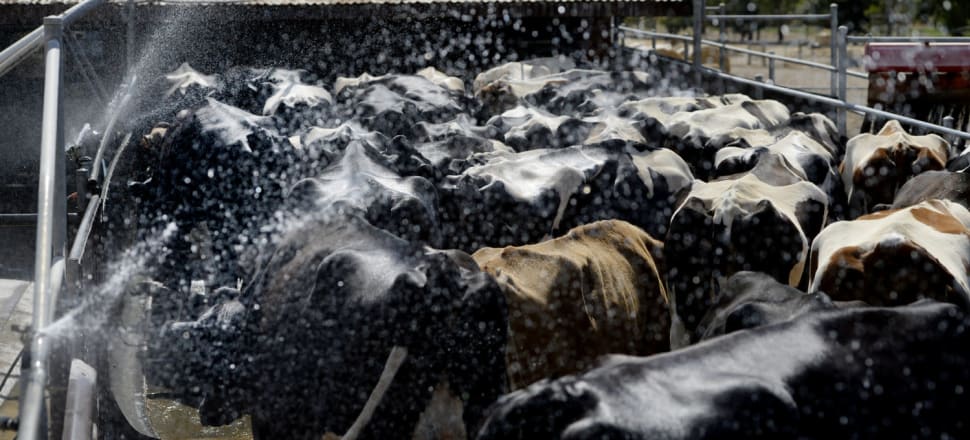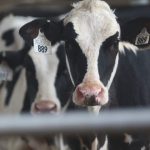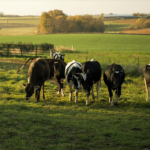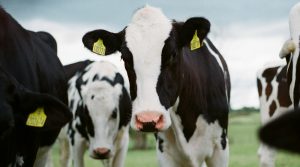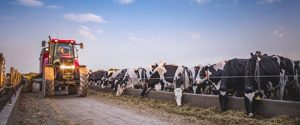
Problems occur if temperature and humidity increase and cows can’t balance their metabolic and environmental heat gains.
Dairy cows need to maintain their core body temperature between 38.6°C and 39.3°C.
Core body temperature changes slightly throughout the day, reaching a peak in the early evening and a low in the early morning.
In hot environmental conditions, cows offload heat with a range of physiological and behavioural strategies.
Metabolic heat is being produced all the time. During the day this heat is not as easily dispersed. If night-time conditions are sufficient to allow adequate dispersal of heat, the cow will not suffer ill effects.
If this diurnal cycle of heat accumulation during the day and loss during the night is disrupted by high night-time temperatures the effects become more noticeable.
The level of environmental heat a cow is exposed to over time is determined by:
● Air temperature and relative humidity.
● Amount of solar radiation.
● Degree of night cooling that occurs.
● Ventilation and air flow.
● Length of the hot conditions.
Unseen responses to excessive heat load
Apart from observable changes in behaviour, there are also unseen physiological changes that occur within the cow:
● Feed intake decreases by 10 per cent to 20 per cent when the air temperature is more than 26°C.
● Core body temperature rises.
● Blood hormone concentrations are changed.
● Blood flow distribution is altered, blood flow to gut, uterus and other internal organs is decreased, blood flow to skin is increased.
The unseen changes can have far-reaching consequences on the productivity, health and welfare of cows.
Temperature and humidity
Increasing air temperature and humidity reduce the cow’s ability to cool itself.
Heat exchange between the cow and the environment occurs through radiation, conduction, convection and evaporation processes.
The direction of heat exchange depends on the temperature difference between the cow and the surrounding environment.
When the air temperature is higher than the cow’s temperature, heat is absorbed.
When the air temperature is lower than the cow’s temperature, the cow offloads heat and cools down.
The greater the temperature difference, the faster the flow of heat.
Top 10 short-term actions to consider during the hot season
● Delay afternoon milking until 5pm.
● Wet the dairy yard for an hour before cows arrive.
● Set up a sprinkler system at the dairy yard.
● Install a large water trough on the exit side of the dairy.
● Sprinkle cows for 30 to 60 minutes while standing in the dairy yard waiting for afternoon milking.
● Increase your cows’ grain and concentrate feeding rate, feed high-quality forage fibre and higher quality protein sources, and increase cows’ intakes of potassium, sodium and magnesium.
● If you don’t have a shade shed, bring the milking herd back to the dairy yard around midday and use the sprinkler system to cool cows. If possible, give them access to high quality hay or silage.
● Provide cows with the highest quality pasture available to graze overnight when they are cooler.
● Mate more heifers to compensate for lower in-calf rates expected in milkers during the hot season to help maintain your desired calving pattern.
● Implement a tree planting program starting with trees on the western side of the yard.
Top 10 long-term actions to consider:
● Review the whole farm for shade.
● Develop a farm plan that incorporates significant tree plantings over time on the northern and western edges of pastures, and plant deciduous trees along laneways.
● Fence-off tree lines to protect tree roots from cow treading and reduce the chance of cows lying down in mud and dung.
● Install a shade cloth over the dairy yard to enhance cow cooling prior to milking.
● Install water troughs in all paddocks and along laneways.
● Combine shade and sprinklers at the dairy yard with a feed-out system for high quality forage or partial mixed ration close by. Ensure cows can move freely between both areas during hot weather.
● Build a shade shed with a solid roof set over a feed pad integrated with a PMR feeding system.
● Install a sprinkler system set with temperature controls in the shade shed over the feed pad which is integrated with the effluent management system.
● Install fans if air movement through the shade shed is inadequate.
● Assess the impact of withholding insemination during hot weather on herd profitability.
For more information, visit: dairyaustralia.com.au
– Dairy Australia
